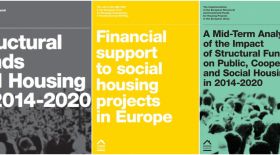A Mid-Term Analysis of the Impact of Structural Funds on Public, Cooperative and Social Housing in 2014-2020
The Implementation of the European Structural and Investment Funds for Housing Projects in the European Union
Brussels, 19 February 2018 | Published in Economy
Housing Europe presents a unique analysis of the implementation of the Structural Funds on affordable housing.
Our Secretary General, Sorcha Edwards introduces the publication:
"After many years, affordable housing is able to be a direct beneficiary under the Structural Funds. In 2014-2020, the approach of Cohesion Policy has significantly improved towards housing compared to the last period: a potentially larger budget for housing, specific allocations in INTERREG and UIA, better combination of funds and more strategic focus. Combining the Structural Funds with the so-called “Juncker Plan” and other programmes also brings new hybrid opportunities of financing besides only private or public sector support.
Since 2007 the Structural Funds contribute to the improvement of housing conditions, thus the quality of people’s lives. Seeing the positive impact of the Funds, a continuation of support to the affordable housing sector is crucial. The previous report of Housing Europe (Structural Funds and housing 2014-2020) showed that in 2014-2020 77% of Operational Programmes allow investment in housing for activities related to promoting energy efficiency as well as activities related to the regeneration of deprived urban areas and social inclusion.
This paper puts an emphasis on affordable housing as a necessary tool to face societal challenges in the EU such as ageing, increasing segregation, climate change, or difficulties to housing young people. In this context, the paper shows the first achievements under the framework of 2014- 2020 highlighting the overall data on the global allocation and planned actions of the different Member States, and offers examples of innovative projects for inspiration.
At the same time, as we draw the lessons from the positive experience, we also look at the reported obstacles for a more efficient and broader use of those funds. The opportunities are made available by Cohesion Policy, however the main challenge for affordable housing providers remains to mobilise the funds at local level and make full use of them.
That is why this paper represents a real added value for the sector, being the first detailed analysis of the implementation of the Structural Funds on affordable housing, and we are confident that this publication is the first step to getting a comprehensive understanding of the state of play and how
to move forward."

